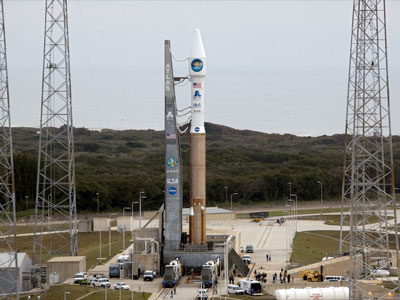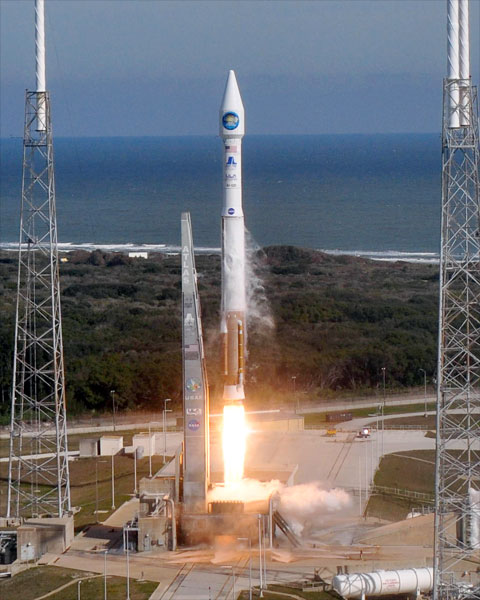The Solar Dynamics Observatory (SDO) will provide a new eye on the sun that will deliver solar images with 10 times better resolution than high-definition television. This mission will zoom in on the cause of severe space weather -- solar activity such as sunspots, solar flares, and coronal mass ejections. Space weather can pose a threat to astronauts as well as to aircraft crews flying over Earth's northern and southern polar regions -- and that's just the tip of the iceberg. Satellite communications, navigation systems, and electrical power to our homes can all be disrupted by magnetic storms triggered by solar activity.
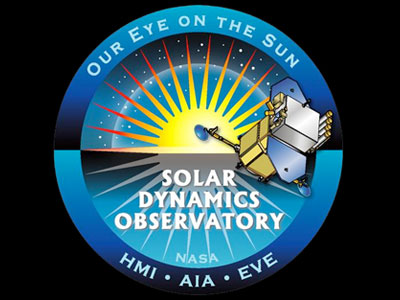
Credit: NASAThe Solar Dynamics Observatory (SDO) is the first mission to be launched for NASA's Living With a Star (LWS) program. The goal of the LWS program is to develop the scientific understanding necessary to effectively address those aspects of the sun and solar system that directly affect life and society. This mission was developed and will be managed by NASA's Goddard Space Flight Center, Greenbelt, Md.
SDO is a 5-year mission that will determine how the sun's magnetic field is generated, structured, and converted into violent solar events like turbulent solar wind, solar flares, and Coronal Mass Ejections (CMEs). The solar wind is a continuous stream of electrically charged particles that flow from the sun and fill the solar system with charged particles and magnetic fields. Solar flares are explosions in the sun's atmosphere, with the largest equal to billions of one-megaton nuclear bombs. CMEs are eruptions from the solar atmosphere that release billions of tons of solar material into interplanetary space at millions of miles per hour. All these phenomena are collectively called space weather. By improving our understanding of the solar activity that powers severe space weather, SDO will enable us to improve predictions of solar storms and provide information necessary to protect our technological systems.
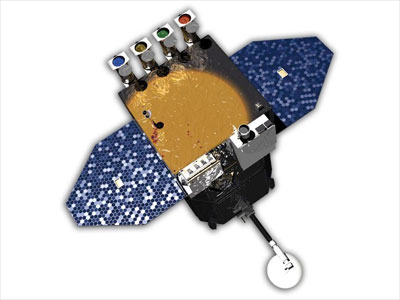
Credit: NASASDO will observe the sun, from its deep interior to the outermost layers of solar atmosphere, at the highest ever time cadence. SDO will snap a full disk image in 8 wavelengths every 10 seconds. This rapid cadence led to placing the satellite into an inclined geosynchronous orbit. This allows for a continuous, high-data-rate contact with a dedicated ground station at the White Sands Complex in southern New Mexico. SDO will send down about 1.5 terabytes of data per day, equivalent to downloading half a million songs each day.
SDO's spatial resolution gives it a tremendous advantage over earlier missions. All solar images will be 4096 pixels x 4096 pixels -- almost IMAX quality -- providing details of the sun and its features that have rarely been seen before.
Instruments on SDO
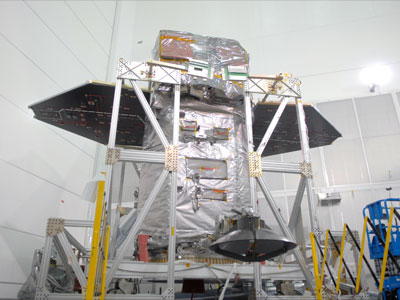
Credit: NASA/Jim GrossmanSDO has three instruments: the Helioseismic and Magnetic Imager (HMI), the Atmospheric Imaging Assembly (AIA), and the Extreme Ultraviolet Variability Experiment (EVE). Instrument partners include the Lockheed Martin Solar & Astrophysics Laboratory of Lockheed Martin's Advanced Technology Center (AIA), Stanford University (HMI), and the University of Colorado at Boulder (EVE).
Helioseismic and Magnetic Imager
The Helioseismic and Magnetic Imager (HMI) will measure sound waves reverberating inside the sun to build up a picture of the interior, similar to the way an ultrasound scan is used to create a picture of an unborn baby. These sound waves can also be used to create images of the far side of the sun, which cannot be seen from Earth. HMI will also measure the strength and direction of magnetic fields emerging on the sun's surface. With these capabilities, HMI will help discover the mechanisms causing the sun's 11-year activity cycle.
Atmospheric Imaging Assembly
The Atmospheric Imaging Assembly (AIA) will take high- resolution pictures of different layers in the sun's atmosphere to further understand how changing solar magnetic fields release the energy that heats the solar corona and creates flares. It will also be used with HMI to link changes in the solar corona to evolution of magnetic fields on the sun's surface and interior.
Extreme Ultraviolet Variability Experiment
The Extreme Ultraviolet Variability Experiment (EVE) will measure the sun's ultraviolet brightness. The sun's extreme ultraviolet output constantly changes. Slow variations in ultraviolet flux affect Earth's atmosphere and climate. Rapid changes in ultraviolet radiation can cause outages in radio communications and affect satellites orbiting Earth. EVE will take measurements of the sun's brightness as often as every ten seconds, providing space weather forecasters with warnings of communications and navigation outages.
Data from SDO will be made available to scientists and the public as soon as possible after it is received from the spacecraft.
Key SDO Facts
SDO will be a major component of the Heliophysics Great Observatory, a fleet of science missions developed by the NASA Heliophysics Division. Each mission concentrates on understanding a different aspect of the sun and its heliosphere - the domain of our sun in the universe. SDO is planned to launch aboard an Atlas V rocket from Cape Canaveral, Fla.
- Total mass of the spacecraft at launch is 3,100 kg (6,800 lb) (payload 290 kg [640 lb]; fuel 1,450 kg [3,086 lb]).
- Overall length along the sun-pointing axis is 4.5 m (14.8 ft), and each side is 2.22 m (7.3 ft).
- Span of the spacecraft with extended solar panels is 6.25 m (20.5 ft).
- Spacecraft command center will be located at NASA's Goddard Space Flight Center.














